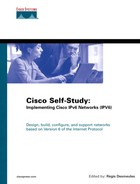Introduction to Routing with IPv6
The IPv6 routing protocols still use the longest-match prefix as the routing algorithm for route selection, as their equivalents did in IPv4. However, because the IPv6 protocols are defined as a new family of protocols, the IPv6 routing table is handled and managed separately from the IPv4 routing table when both protocols are enabled simultaneously on a router.
The following sections cover these topics:
IPv6 routing table on the router— This section briefly describes the commands used to display the IPv6 routing table in the Cisco IOS Software technology.
Administrative distances of the routing protocols— The administrative distances of the IPv6-supported routing protocols remain unchanged in comparison with their equivalents in IPv4.
Displaying the IPv6 Routing Table
The most important task of any intermediary router in a network receiving IP datagrams is determining the best path to the destination. Then the intermediary router forwards each IP packet on the next network segment to reach another intermediary router that repeats the same process up to the final destination. To determine the best path during the forwarding process, the routers use a routing table that points out the next network segment to use. The routing table contains entries either defined dynamically through routing protocols or statically configured by network administrators.
As soon as the ipv6 unicast-routing command is enabled in the Cisco IOS Software, as discussed in Chapter 2, “IPv6 Addressing,” the router can forward IPv6 packets between its interfaces using the IPv6 routing table.
show ipv6 route is a new command that displays the IPv6 routing table in the Cisco IOS Software that contains the list of destination network routes with the mask, the output interface, the type of route (C for connected, S for static, and so on), and each route's administrative distance. This command is equivalent to the well-known show ip route command in IPv4.
Example 4-1 shows the show ipv6 route command. This example shows that several aggregatable global unicast routes, such as 2001:410:ffff:1::/64, 2002:410:ffff:2::/64, and 3ffe:b00:ffff:1::/64, are pointing out the router's interfaces. The routes are related to the link-local prefix FE80::/10 and the multicast prefix FF00::/10, which also appear in the routing table. These routes are automatically included by the router in the IPv6 routing table. Finally, the last entry in the routing table displays a default IPv6 route (::/0) added statically by the network administrator.
Example 4-1. Displaying IPv6 Routes Using the show ipv6 route Command
Administrative Distances
Administrative distance is a value representing a routing protocol's reliability. Over time, routing protocols were prioritized from the most-reliable to the least-reliable using the administrative distance values. During the forwarding process, the routers use the administrative distance to select the best path when several routes using different routing protocols point to the same destination network. The lower the administrative distance value, the more prioritized the route for the router. The administrative distances of IPv6-supported routing protocols are unchanged from the equivalent protocols in IPv4. Table 4-1 shows the administrative distances of each IPv6 routing protocol supported in the Cisco IOS Software technology.
| Routing Protocol | Administrative Distance (Default) |
|---|---|
| Connected interface | 0 |
| Static route (toward the interface) | 0 |
| Static route (toward the next hop) | 1 |
| External BGP (eBGP) | 20 |
| OSPF | 110 |
| IS-IS | 115 |
| RIP | 120 |
| Internal BGP (iBGP) | 200 |
NOTE
Table 4-1 shows the routing protocols with IPv6 support that currently are supported in the Cisco IOS Software. Other IPv4 routing protocols such as Interior Gateway Routing Protocol (IGRP), internal Enhanced Interior Gateway Routing Protocol (EIGRP), external Exterior Gateway Protocol (EGP), and External EIGRP, are not listed in this table. Only EIGRP is considered by Cisco as a potential candidate for an IPv6 implementation.
